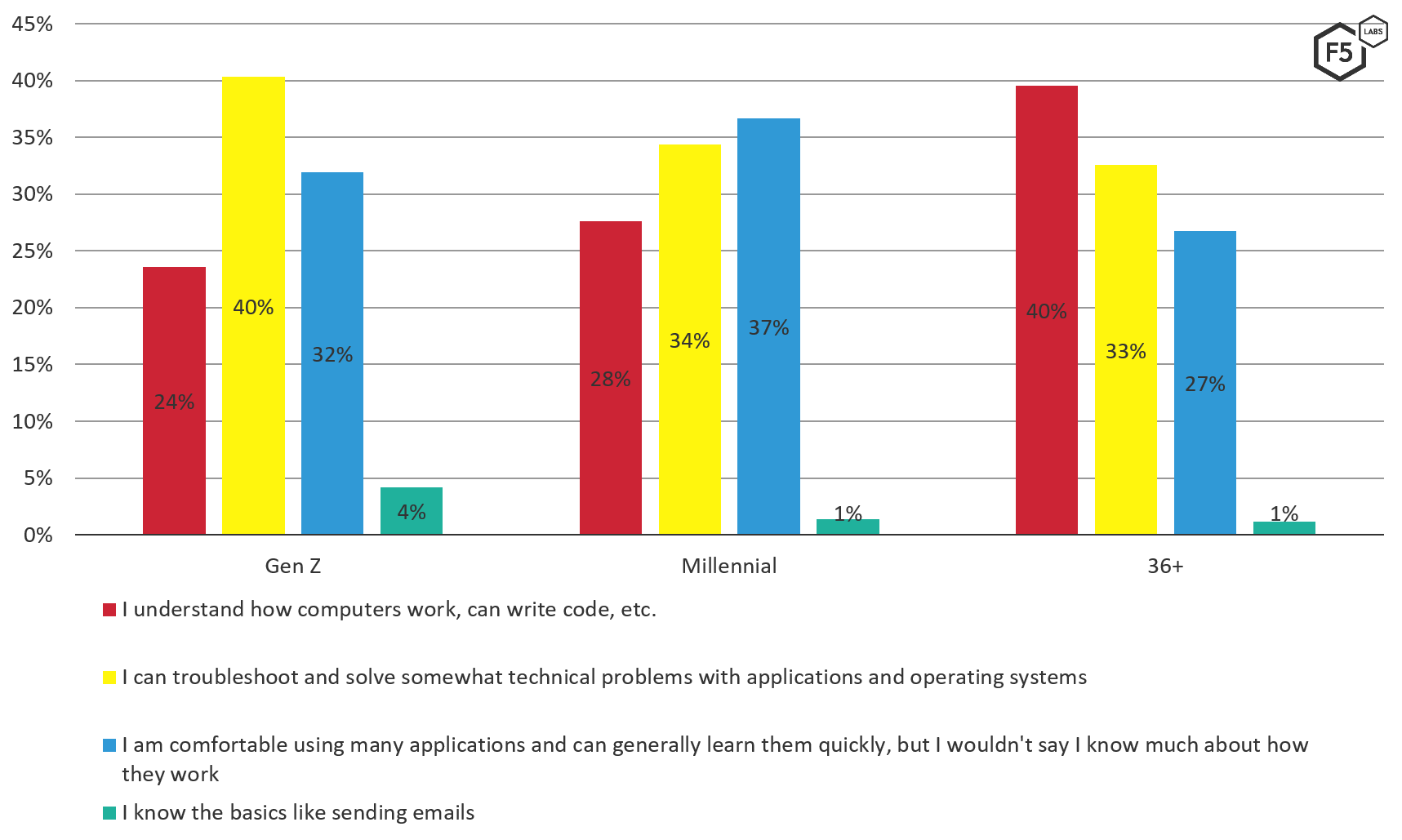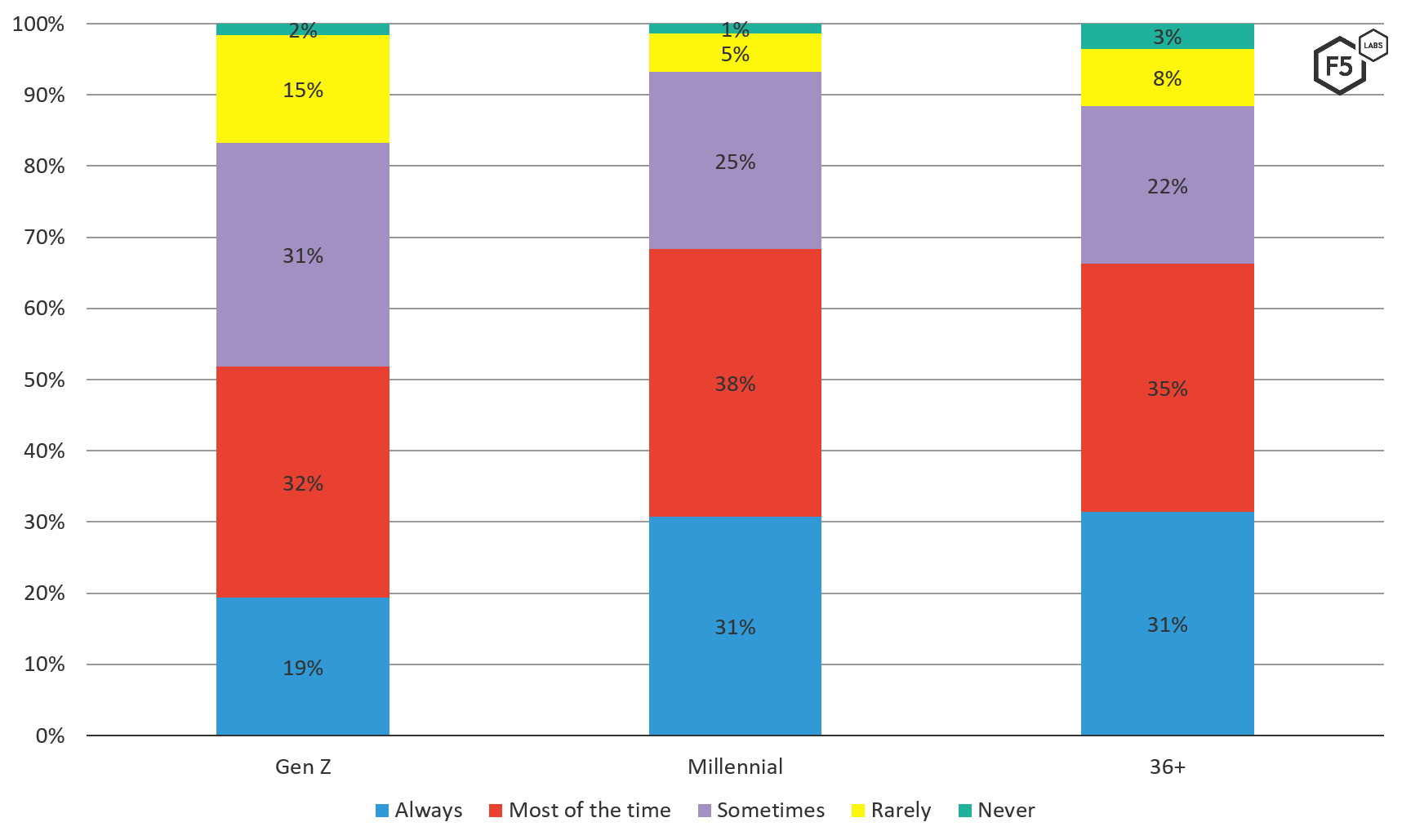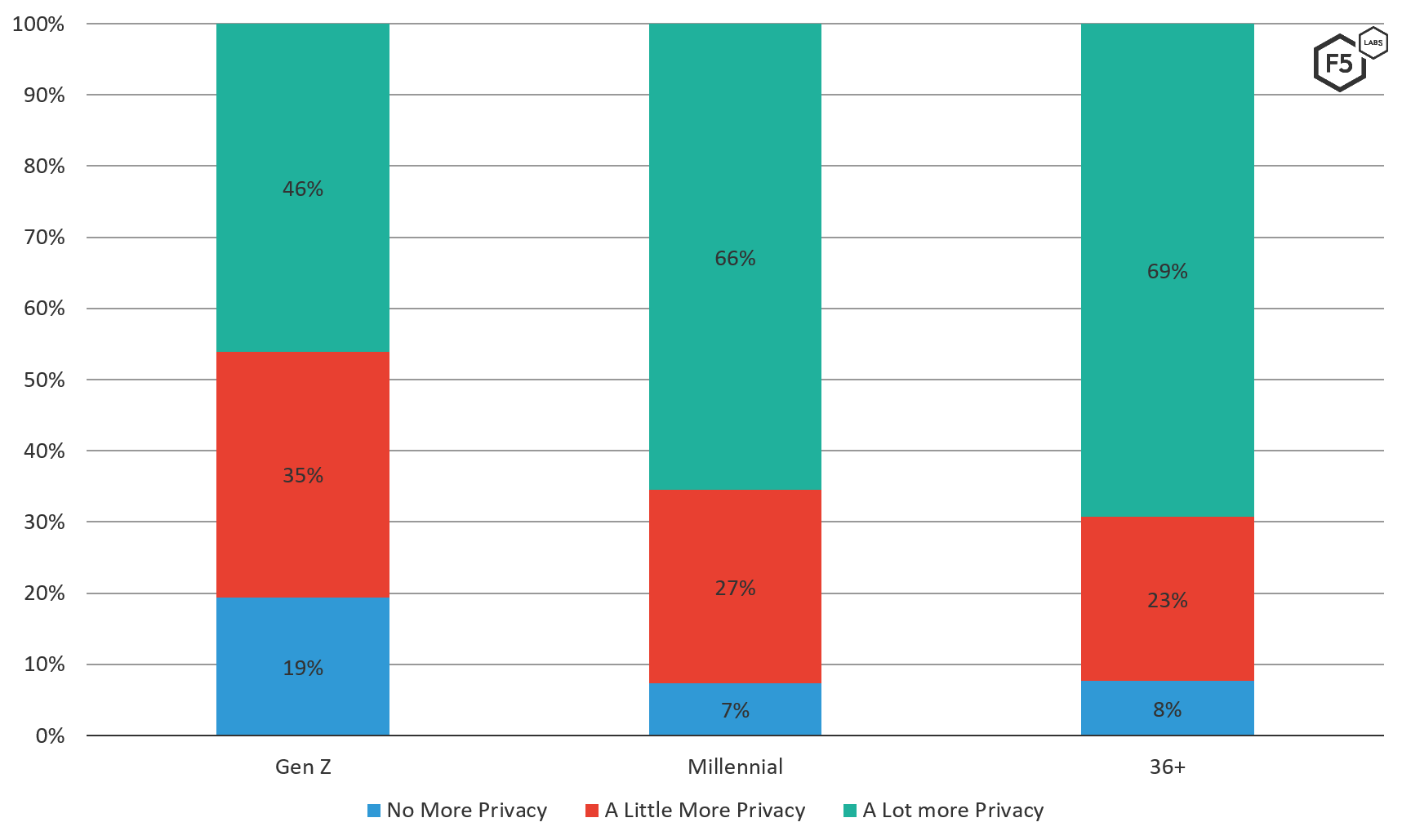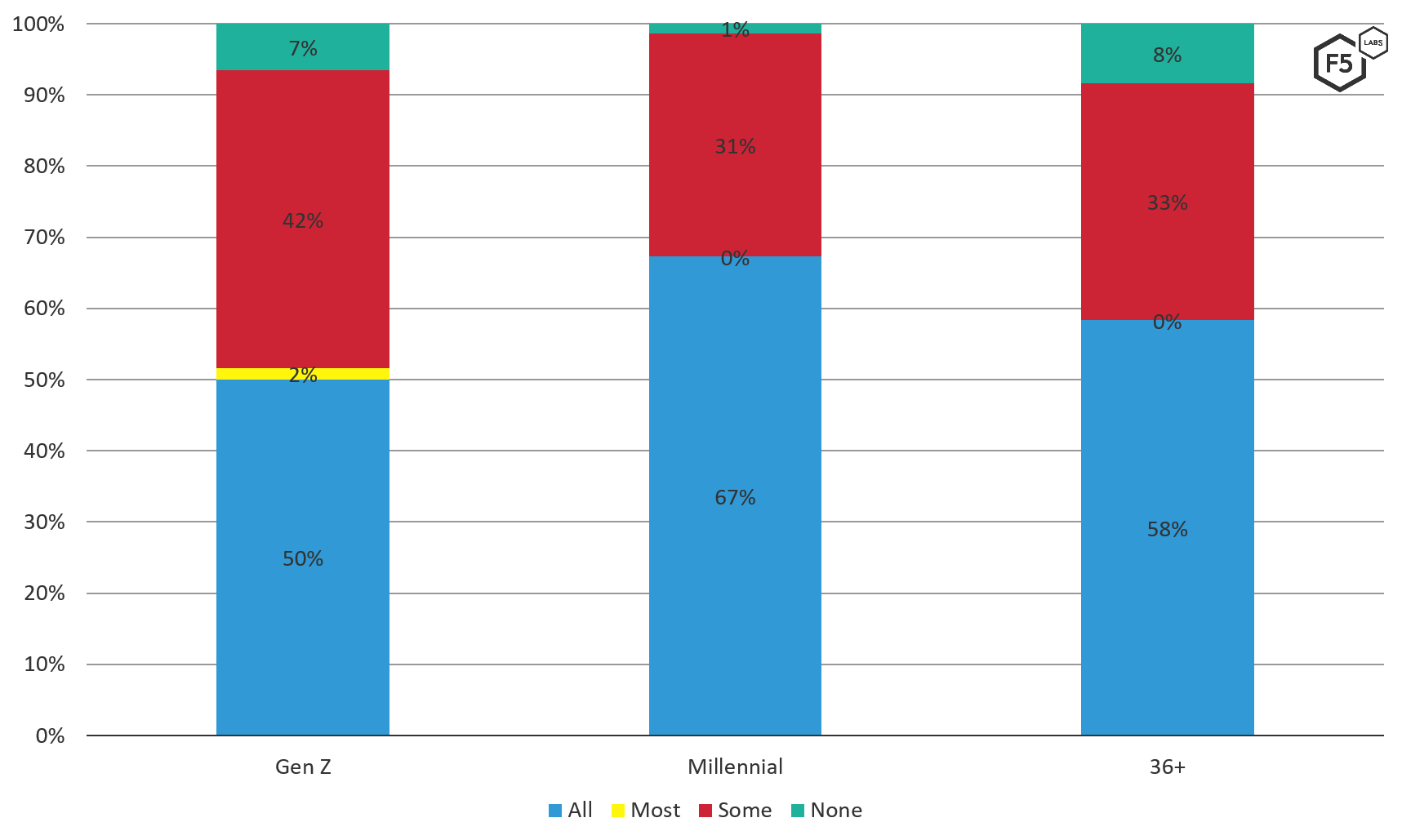Do Gen Z-ers (individuals age 8 to 22) think and behave differently towards technology than previous generations? Specifically, are their attitudes and digital habits around privacy and security different from Millennials (age 23 to 35),1 who grew up with less technology? What about compared to Gen X-ers (age 36 to 55)? When F5 Labs was approached about hosting a research internship for three high school seniors, we realized it was the perfect opportunity to discover how Gen Z-ers use the Internet and think about cybersecurity and online privacy. After giving the interns a crash course in how to write unbiased survey questions, we crossed our fingers and hoped that after distributing them to their peers, classmates, friends, family, and other associates, we’d get a significant number of responses to analyze results.
Fast forward—the results are in!
Key findings:
- No matter the age, digital habits did not differ significantly across generations; where one generation practiced safety online, the others did, as well.
- Thirty-one percent of Millennials and Gen X-ers said they always consider the impact of things they post online compared to only 19% of Gen Z-ers.
- While the majority of respondents in every age group said they wanted more privacy online, it’s notable that nearly 20% of Gen Z-ers said they did not want more privacy online.
- The realization that nothing or almost nothing is private online increases with age (68% for Gen Z, 73% for Millennials, and 86% for Gen X).
- Ironically, nearly 60% of Gen Z-ers, the generation known for having been “brought up” on technology, said they have not received education about safety online.
- Increased education is paramount in bettering digital habits across the board. As people get older, they are likely to see some form of formal education in a workplace or university, but it is important that as people grow up with more technology around them, they get this education at a younger age.
Who We Surveyed and Why
To understand the mindset and digital habits of Gen Z-ers, we broke the 50-question survey into five sections: Demographics, Digital/ Cybersecurity Habits, Social Media Use, Privacy Habits, and Password Habits. We asked a variety of questions, some to provide context and others (opinion-based questions) to further quantify the knowledge-based questions. No questions required a write-in answer, although some provided that option.
Over 700 individuals responded to the survey, however, with the constraints and limitations placed on the data (see the Methodology section), about 520 responses were used. We did not use any data from individuals under 18, however there has been other research conducted on children’s password habits, which indicate that children tend to use age appropriate words and phrases in creating and maintaining passwords.2
The gender distribution was fairly even, with 49.42% of respondents identifying as male, 47.49% identifying as female, and 3.09% identifying as non-binary.
The age distribution from all survey respondents was fairly consistent across target categories (Gen Z and Millennials). When controlling for the responses that could be used for publishing,3 the age distribution remained consistent, with Millennial and Gen Z participation much higher than Gen X, which can be seen in Table 1.
| Age group | Percentage |
| 18-22 | 38.5 % |
| 23-35 | 44.1 % |
| 36 + | 17 % |
Table 1. Age distribution, controlled for eligible respondents
Across the U.S., all regions were represented fairly equally. Although the intern team was based in Seattle, the Pacific Northwest region did not dominate the results; in fact, respondents from 44 different states (and Washington, DC) and 28 different countries are represented.
What Respondents Shared with Us
We asked survey participants about everything from their password habits, browser privacy settings, and social media practices to concerns about hackers, targeted email marketing, facial recognition software, and IOT devices capable of eavesdropping. We’ll cover some of their answers in Part 2 of this article series; below we look at responses to some of the more basic questions we asked.
“How Tech Savvy Are You?”
A majority of Gen Z participants considered themselves fairly tech savvy, with 64.46% stating they could troubleshoot and solve problems and understood how computers work. Breaking that out further, both Gen Z-ers and Millennials answered almost equally that they were tech savvy enough, not just to troubleshoot but also to fix minor computer issues. More Millennials 28% were confident in their computer programming skills than Gen Z-ers, at 24%. These responses were not entirely surprising, given that some Millennials and Gen X-ers may have had career or academic opportunities to learn and develop these skills.

Figure 1. Responses to the survey question "How tech savvy are you?"
Notably, although the majority of participants of this survey rated themselves as tech savvy, many did not always consider the impact of the content they post online. The team anticipated a big difference between responses from Millennials and Gen Z on this question, but the difference was not as significant as expected. Thirty-one percent of Millennials said they “Always” consider the impact of the things they post online, compared to 19% for Gen Z-ers. Thirty-eight percent of Millennials said they “Mostly” think about the impact, compared to 32% of Gen Z-ers. About a quarter of all three groups said they were only “Sometimes” concerned with the impact of content they post online.

Figure 2. The distribution of answers to the question "How often do you consider the impact of the things you post online?”
Desires and Expectations of Privacy Online
One question the team hoped to gain insight around was, “How much privacy do you want online?” This question was used as a pivot point for many other questions. For instance, if respondents wanted more online privacy, were they taking steps to maintain protect themselves? The team originally postulated that there would be a difference between Gen Z‑ers and other respondents. However, once results were compared, it was evident that across all age groups, participants felt similarly about the need for more privacy online.
In every age range, the majority of respondents said they wanted more privacy online. There were small differences as the age of respondents progressed. Even so, Gen Z-ers notably had the highest number of responses saying they did not want more privacy.

Figure 3. Distribution of survey respondents’ answers to the question, "How much privacy do you want online?"
The responses to this question make sense when compared directly to how much data respondents think is private online. Among progressively older age groups, fewer respondents thought that much of their personal information online was private.
| How much information do you think is private online? | |||||
| Age group | Nothing | Almost Nothing | Some information | Most Things | Everything |
| 18-22 | 25% | 43% | 27% | 3% | 2% |
| 23-35 | 33% | 40% | 25% | 1% | 0% |
| 36+ | 45% | 41% | 12% | 3% | 0% |
Table 2. Across all age groups, the majority believe that nothing or almost nothing is private online.
Taking Proactive Steps to Improve Privacy
So, if the majority of respondents don’t believe that their data is private but they want more privacy online, are they taking precautions to protect their personal information?
Across all age ranges, participants answered that they do adjust privacy settings where possible. Notably, the team found that the large majority of participants adjust at least some of their account settings, although Millennials practice more privacy adjustments on all of their accounts (67% of Millennials vs 50% of Gen Z participants).

Figure 4. Responses to the question, “For how many social media accounts do you adjust the privacy settings?”
In each age range, over 90% of the survey participants said they change privacy settings for “all,” “most,” or “some” of their social media accounts. Although there was not a significant difference in specific responses across all age ranges, it is notable that participants knew they could adjust privacy settings.
Use of Two-Factor Authentication
We also wanted to know about the use of two-factor authentication (2FA). Respondents were specifically asked, “Do you use two-factor authentication for any of your accounts (for example, do you get codes sent to your mobile phone when you log in)?” The team assumed that this short example would provide enough clarity about what 2FA is. (More on the significance of this next.) A very high percentage of respondents said they do use 2FA for accounts that offer it, and there was no notable difference in habits between age groups.
| Do you use two-factor authentication? | ||||
| Age group | Yes, for the accounts that offer it | No, even if my accounts offer it | None of my accounts offer it | What’s that? |
| 18-22 | 83.8% | 10.% | 1.3% | 5.% |
| 23-35 | 92.4% | 6.6% | 0% | 1.% |
| 36+ | 85.5% | 7.9% | 5.3% | 1.3% |
This high percentage of positive responses was a bit surprising since several other studies indicate that even the most tech savvy Millennials do not use 2FA all the time, when offered.4 The team postulated that perhaps respondents didn’t really understand 2FA—in other words, authentication that is (typically) dependent on something you know and something you have. In the absence of a follow-up question to clarify whether, for example, respondents use 2FA to set up a new account but not to log into an account every time, these results might be inaccurate. It’s likely these responses are not representative of the Gen Z population as a whole. They could possibly reflect a common problem with surveys called “response bias,” in which respondents are inclined to answer in ways that are socially acceptable or expected.5
Use of Virtual Private Networks
The team was also curious to know if participants took precautions against being monitored online, for instance, by using a virtual private network (VPN). Although the difference in responses was not exceptionally large, it is notable that 26.24% of Gen Z participants regularly use a VPN or proxy in order to achieve some level of anonymity, and mask location information online compared to 19.65% of Millennial participants.

Figure 5. Distribution of survey participants who already use a VPN online in order to not be tracked
The results here are worth noting and indicate that Gen Z-ers may be more knowledgeable about new ways to remain somewhat anonymous online. On the other hand, these responses could also be attributed to the fact that many Gen Z-ers and some Millennials use VPNs in order to watch TV shows online or access streaming sites while out of their home country. Some streaming sites have caught on and are changing their terms and conditions to expressly forbid this, although it doesn’t deter everyone.6 Because Gen Z-ers are growing up with more technology than ever before, perhaps they are more creative about getting access to what they’re interested in. This speculation about why Gen Z-ers may be heavier users of VPNs is interesting, however, we can’t correlate the Gen Z responses to those of other age groups since we did not ask follow-up questions about what VPNs were being used for specifically.
Education about Online Safety
Formal and informal education about practicing safety online, protecting accounts online, and general cybersecurity remains important. Fifty-nine percent of Gen Z participants said they have not had cyber security education.
| Have you received education or online classes about safety on the Internet? | ||
| Age group | No | Yes |
| 18-22 | 59% | 41% |
| 23-35 | 41% | 59% |
| 36+ | 43% | 57% |
The percentage of yes responses among older respondents could be attributed to the fact that many workplaces require regular training sessions for computer and Internet usage. It is essential to note, however, that a large number of Gen Z-ers are starting out without this information during a critical time of their education and careers. The importance of teaching students about online safety has been a topic of discussion within the education community for years. These classes can be useful to quell online bullying and help teens prepare to leave home where their digital lives may be scrutinized by college admissions boards and future employers.
Conclusions
While the team expected to see a significant difference in the way that Gen Z-ers and Millennials looked at and used technology, the results showed that overall, digital habits across generations are more similar than different. Although most survey participants stated that they knew many security concepts (for example, what makes a strong password), we noted that most participants didn’t want to go out of their way to increase their security online. As companies push security onto users, they also need to understand that safety online and digital habits of users aren’t necessarily changing with age (or youth!). Enterprises should not make the mistake of assuming that younger generations are more security conscious just because they grew up with technology.
To raise security awareness, it is essential that teens, young adults, working professionals, and really everyone, talk about cyber security best practices and what good digital hygiene means. Companies, schools, and parents need to continue to think of innovative ways to keep teaching about and discussing security. Based on the results of this survey, it is clear that while many people are learning more about online safety than ever before, digital habits are not significantly different across generations. Academic education is only taking Gen Z-ers so far. As companies look to hire new employees across all age groups, it’s imperative they recognize this ongoing educational gap and remain committed to providing security awareness training.
This article is Part 1 of a two-part series on the results of this survey comparing Gen Z and Millennial cybersecurity habits. Part 2 focuses on the Internet of things (IoT) and how perceptions around IOT are steadily driving our country closer and closer to a surveillance state similar to that in China. Join the conversation on Twitter or other social media to talk to us about Internet security habits you’ve observed.


